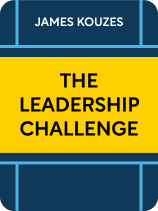

This article is an excerpt from the Shortform book guide to "The Leadership Challenge" by James M. Kouzes and Barry Z. Posner. Shortform has the world's best summaries and analyses of books you should be reading.
Like this article? Sign up for a free trial here .
What do Posner and Kouzes mean by “enable others to act” in the context of leadership? What can you, as a leader, do to develop a sense of agency in your subordinates?
“Enable others to act” is the fourth principle of Posner and Kouzes’ outstanding leadership. There are two overall guidelines to achieve this: 1) foster collaboration amongst your team members, and 2) build their sense of self-determination by strengthening their competence and confidence.
We’ll discuss these two concepts below.
1. Foster Collaboration
The success of your project and your leadership depends on a sense of shared creation and shared responsibility. Consistently, research shows that leaders who cultivate cooperative relationships in their team are viewed as highly effective and inspire the highest levels of engagement.
To enable others to act collaboratively, you must:
- Build a climate of trust.
- Promote relationships.
Build a Climate of Trust
Trust is integral to human relationships and to leadership. Trust is needed in every type of relationship within a team:
- From leader to team: You must trust the efforts of other people or you’ll end up as merely a manager or supervisor, micromanaging everyone’s work, instead of a leader.
- From team to leader: If your team doesn’t trust you, they won’t follow you. They won’t believe in your vision or put in extra effort to make it come true.
- Among team members: Your team members must trust that they can express their thoughts openly and honestly and if they fail at a task, their teammates won’t judge them.
Studies show that people who are trusting are happier and more psychologically well-adjusted than those who see the world with suspicion. Higher levels of trust strongly predict higher organizational performance across a range of markers, including customer loyalty, market share, ethical behavior, and profit growth—for example, the stock performance of companies considered trustworthy is routinely 1.8 times higher than the S&P 500. Therefore, building a trusting team is a foundational step in your success.
Create a climate of trust by allowing your team to do the work you assigned them without close oversight. Encourage them to solve problems on their own. Empower them to make decisions and to use their expertise in the way they feel best.
Facilitate Relationships
Because people work together best when they trust each other, encourage and foster healthy, trusting relationships among your team members. To do this, follow these practices:
- Develop Common Goals. Shared goals unite people in cooperative efforts, in which everyone feels that their success contributes to everyone else’s success, and that no one can be successful unless everyone works together. Structure your team’s roles and responsibilities so that their individual objectives contribute to a larger objective, and make sure they see how the two are connected.
- Encourage Reciprocity. Reciprocity is the basis of trusting relationships: the belief that others will treat you as you treat them. People like to think that if they help someone, that person will return the favor at some point in the future. Encourage your team members to be available to each other to help whenever any of them needs it. Additionally, model reciprocity by going out of your way to repay favors for those who have helped you.
- Reward Joint Effort. Large, ambitious goals can’t be accomplished by one person alone, and cooperative teams produce better results than competitive teams, so when talking about the success of any project your team is working on, emphasize the collective results rather than individual results. This will encourage your team to see that there’s a greater payoff in working together than working alone.
- Encourage Face-to-Face Interactions. Getting to know other people is important in establishing trusting and collaborative relationships. Therefore, encourage in-person meetings whenever feasible. You can accomplish this through online webcams if your workforce is dispersed, as happens in global companies. In virtual meetings, encourage participants to turn their cameras on, so others have more than just a name and a voice to go by.
2. Strengthen Your Team Members
The real job of a leader isn’t to seek power for themselves but to empower others to lead themselves. When you go beyond leading and show people how to lead themselves, you become more than a leader—you become a coach, helping others to help themselves. Too often, people mistakenly assume that the mark of a leader is wielding power over others, but paradoxically, when you give your power away, you actually become a more powerful leader yourself.
Leaders who empower people end up with a stronger team:
- Team members who feel more accountable for their success or failure feel more invested in the project.
- Sharing your power with others increases trust in the group, as team members feel respected and valued.
To strengthen your team:
- Build a sense of self-determination.
- Develop competence and confidence.
Build a Sense of Self-Determination
People who feel strong and capable under your leadership will perform well. People who feel empowered feel that:
- They’re in control of their jobs and their futures.
- They have discretion as to how to handle situations.
- They’re involved in key planning decisions.
- Important information is shared with them.
- Their supervisors encourage them, coach them, and invest resources in them.
To empower your team, foster a culture where you expect input. Make every team member feel they’re expected to contribute to projects in a meaningful way by giving ideas and helping with strategy. This will help them see themselves as integral and valued parts of the team and will give them confidence to take initiative.
In addition:
- Allow for Choices. When people are able to make choices, they feel more personally responsible for a project and are less likely to blame their supervisors or teammates if things go wrong. Further, they’re more likely to take initiative to fix a problem if things do go wrong, not only because they’ll feel empowered to, but also because they’ll feel the project reflects on them more directly, and will therefore want it to succeed.
- Increase Accountability. To increase your team members’ sense of accountability—their feeling of responsibility and their desire to proactively take care of their tasks—foster a sense of ownership. You can increase your team members’ accountability and sense of ownership by giving them something concrete to control. For example:
- Ensure that everyone has a customer—someone they answer to, no matter what the task.
- Increase signature authority.
- Remove unnecessary approval steps, so that people don’t have to check with superiors unless it’s needed.
- Provide vertical and horizontal access to information and resources both inside and outside the organization—make sure that when you assign responsibility for a task, that person has the resources necessary to complete it.
Develop Competence and Confidence
To truly empower your team, go beyond just providing them choices and fostering accountability. Help them to feel competent and confident in their roles. To do this, ensure that everyone has the knowledge, skills, and resources to do their jobs, or instead of feeling competent and confident, they’ll feel overwhelmed and discouraged.
Most people realize that competence is important, but confidence is just as crucial. In fact, studies have shown that self-confidence is an even stronger predictor of performance than skill level or training.
To strengthen the competence and confidence of your team:
- Challenge their skills.
- Share information.
- Educate about key company metrics.
- Foster a growth mindset.
- Coach.
Challenge Their Skills
People do their best work when their task is slightly more challenging than their skill level. That’s when they feel neither overwhelmed nor bored. It’s also when they report feeling “in the flow,” which is the sense that they’re performing expertly even if the challenge is difficult. When people are performing at this level, they’re gaining competence by stretching their skills and confidence by seeing their progress, and they’re most satisfied with their work.
As a leader, aim to provide the conditions that make flow possible. This means periodically assessing your team members’ skill levels and the difficulties of the challenges they face, to make sure that their skills and challenges don’t become unbalanced.
(Shortform note: For more about what flow is, how it affects happiness, and how to cultivate it, read our guide to Flow by Mihaly Csikszentmihalyi.)
Share Information
Your team won’t be able to make decisions without adequate information and training, and they’ll be hesitant to exercise their judgment for fear of making mistakes. Therefore, when guiding your team to become more self-sufficient, increase your investment in training and development.
Employees value skills training highly and are more likely to stick with a company that provides it. In fact, studies show that 40% of employees who report little or no skills training leave their positions within the first year, citing the lack of training as the reason.
Another reason to invest in training and development is that in today’s world, industries and technologies change very quickly, and it benefits you and your organization to have team members who can adapt to changing needs. An adaptable and flexible workforce will lessen the need for you to hire from the outside or lose market opportunities.
An example of a manager who successfully encouraged his team members to learn and share information was Jeff Allison of PW Enterprises. When a reorganization required him to be off-site and away from his team for much of the workweek, he knew he’d have to empower them to solve problems without his oversight. He spent a month walking them through a few dozen recent problems he’d faced, making sure they had the information and skills needed to resolve similar situations. Additionally, he gave each employee a hypothetical problem, challenged them to solve it, and had them each present their process to the rest of the team. This allowed them to not only learn from him but also from each other, which accelerated the learning process.
Educate About Key Company Metrics
Make sure your team members understand the fundamentals of how your organization works, so they’re able to make critical decisions about key issues when needed. If your team members don’t understand how your organization works, they won’t have a sense of ownership and can’t step up into leadership roles. Educate them about important elements of your organization, including its:
- Most important customers, clients, suppliers, and stakeholders
- Goals and how you measure progress toward them
- Track record of performance
- Pipeline of products, services, or ideas
Foster a Growth Mindset
When a person has a growth mindset as opposed to a fixed mindset, which we discussed under Guideline 6r, they’re more likely to develop confidence and competence. Research shows that people who are told that decision-making is a skill that can improve through practice (a characteristic of growth mindsets) have more confidence and better results than people who are told that decision-making is a reflection of innate intelligence (a characteristic of fixed mindsets).
When people believe in themselves in this way, messages of self-confidence can mold their thinking. Research shows that people are also susceptible to messages regarding whether or not they have the ability to effect change in other people (in addition to change in themselves), and their confidence is shaped by those messages. Studies show that groups who are told they can influence their colleagues’ decisions are more confident—and also perform better—than groups who are told that they’re unlikely to influence their colleagues’ behavior.
Coach
Coaching is the process of giving constructive feedback, asking probing questions, and actively teaching important concepts. Coaching is different from training; in fact, job training must be accompanied by coaching for it to improve job performance. In a three-year study, employees who had ongoing coaching conversations with their managers after receiving training were four times as likely to be recognized as “high improvement learners” than were employees who received training but no coaching afterward.
As a coach, your role is to help your team member to achieve her goals not by showing her what to do, but by showing her how to figure it out for herself. When you help another person grow, that person tends to reciprocate by helping you grow—by helping you achieve your organizational goals. This is why consistently, employees who receive coaching report feeling strongly supported by their company and committed to the company in turn.
One of the most effective ways to coach someone is to ask lots of questions, which:
- Allows the other person to think about a situation from their perspective
- Indicates trust in the other person’s opinions and abilities
- Creates buy-in for whatever decision you ultimately reach, since you involved the other person

———End of Preview———
Like what you just read? Read the rest of the world's best book summary and analysis of James M. Kouzes and Barry Z. Posner's "The Leadership Challenge" at Shortform .
Here's what you'll find in our full The Leadership Challenge summary :
- A field guide for becoming the kind of leader that other people want to follow
- The five principles of leadership and their associated guidelines
- Why before you can lead others, you must have a clear understanding of yourself






